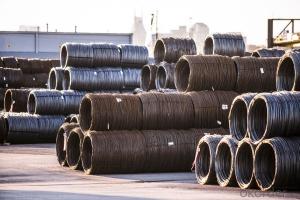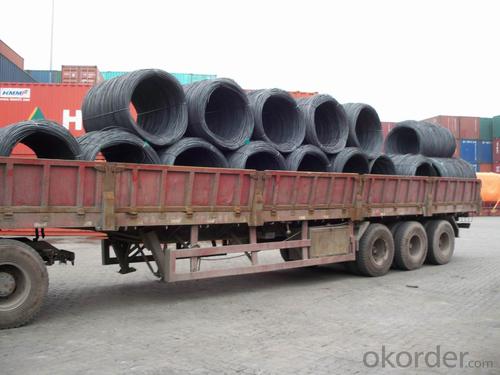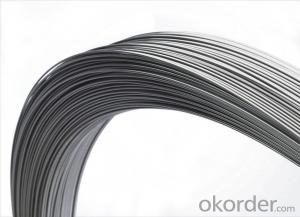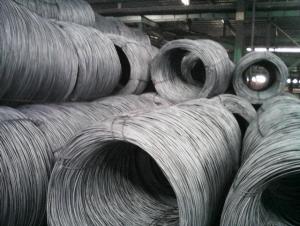SAE1006Cr Carbon Steel Wire Rod 6.5mm for Welding
- Loading Port:
- Shanghai
- Payment Terms:
- TT OR LC
- Min Order Qty:
- 100 m.t
- Supply Capability:
- 30000 m.t/month
OKorder Service Pledge
OKorder Financial Service
You Might Also Like
Specification
Description of SAE1006Cr Carbon Steel Wire Rod 6.5mm for Welding:
OKorder is offering Color Coated Steel Coil Prepainted Steel Coil at great prices with worldwide shipping. Our supplier is a world-class manufacturer of steel, with our products utilized the world over. OKorder annually supplies products to European, North American and Asian markets. We provide quotations within 24 hours of receiving an inquiry and guarantee competitive prices.

Applications of SAE1006Cr Carbon Steel Wire Rod 6.5mm for Welding:
Color Coated Steel Coil Prepainted Steel Coil are ideal for structural applications and are widely used in the construction of buildings and bridges, and the manufacturing, petrochemical, and transportation industries.
Main Product Features of SAE1006Cr Carbon Steel Wire Rod 6.5mm for Welding:
· Premium quality
· Prompt delivery & seaworthy packing (30 days after receiving deposit)
· Corrosion resistance
· Can be recycled and reused
· Mill test certification
· Professional Service
· Competitive pricing
Specifications of SAE1006Cr Carbon Steel Wire Rod 6.5mm for Welding:
PPGI:
1, Introduction: Color coated steel coils(sheets), i. E. PPGI, also called prepainted steel coils(sheets), are made of galvanized steel coils(sheets) with polymer coatings as surface. It's a new enclosure material and building board with characteristics of light-weighted, heat preserved&insulated, easily installed with bright colors.
2, Production Process: Pretreatment(Degreasing)_Drying_Chromating_Paint Basic Oil_Cooling_Drying_Color Coating_Cooling_Film-covering_Rolling Up
3, Characteristics:
Good at corrosion resistence. Besides zinc coating of the basic plate of galvanized steel sheet, the color coating as the surface has double lifetime to ensure better anticorrosion effect.
With excellent cold bending molded manufacturablity, PPGI products can be processed or directly used as final product. As being light-weighted and conveniently transported, they're widly used to replace wood to save energy.
There're thousands of colors can be chosen as per different application. Any color plays well in decoration.
No pollution with high recycling rate, PPGI coils and sheets are strongly recommended as enviroment-friendly products by the government.
5, eye bands and 4 circumferential bands in steel, galvanized metal fluted rings on inner and outer edges, galvanized.
| commodity | SAE1006Cr Carbon Steel Wire Rod 6.5mm for Welding |
| Techinical Standard: | JIS G3302-1998, EN10142/10137, ASTM A755 |
| grade | Q195,Q215,Q235,SAE1006,SAE1008 SAE1006Cr |
| Types: | Mesh welding |
| Base metal | galvanized, galvalume, cold rolled steel |
| Thickness | 0.14-1.0mm(0.16-0.8mm is the most advantage thickness) |
| Width | 610/724/820/914/1000/1200/1219/1220/1250mm |
| Type of coating: | PE, SMP, PVDF |
| Zinc coating | Z60-150g/m2 or AZ40-100g/m2 |
| Top painting: | 5 mic. Primer + 15 mc. R. M. P. |
| Back painting: | 5-7 mic. EP |
| Color: | According to RAL standard |
| ID coil | 508mm610mm |
| Coil weight: | 2--3MT |
| Package: | Properly packed for ocean freight exportation in 20'containers |
| Application: | Industrial panels, roofing and siding for painting/automobile |
| Price terms | FOB, CFR, CIF |
| Payment terms | 20%TT in advance+80% TT or irrevocable 80%L/C at sight |
| delivery time | 25 days after recepit of 20% TT |
| Remarks | Insurance is all risks |
| MTC 3.1 will be handed on with shipping documents | |
| We accept SGS certificatation test |

FAQ of SAE1006Cr Carbon Steel Wire Rod 6.5mm for Welding:
Q1: Why buy Materials & Equipment from OKorder.com?
A1: All products offered byOKorder.com are carefully selected from China's most reliable manufacturing enterprises. Through its ISO certifications, OKorder.com adheres to the highest standards and a commitment to supply chain safety and customer satisfaction.
Q2: How do we guarantee the quality of our products?
A2: We have established an advanced quality management system which conducts strict quality tests at every step, from raw materials to the final product. At the same time, we provide extensive follow-up service assurances as required.
Q3: How soon can we receive the product after purchase?
A3: Within three days of placing an order, we will begin production. The specific shipping date is dependent upon international and government factors, but is typically 7 to 10 workdays.
Q4: What makes stainless steel stainless?
A4: Stainless steel must contain at least 10.5 % chromium. It is this element that reacts with the oxygen in the air to form a complex chrome-oxide surface layer that is invisible but strong enough to prevent further oxygen from "staining" (rusting) the surface. Higher levels of chromium and the addition of other alloying elements such as nickel and molybdenum enhance this surface layer and improve the corrosion resistance of the stainless material.
Q5: Can stainless steel rust?
A5: Stainless does not "rust" as you think of regular steel rusting with a red oxide on the surface that flakes off. If you see red rust it is probably due to some iron particles that have contaminated the surface of the stainless steel and it is these iron particles that are rusting. Look at the source of the rusting and see if you can remove it from the surface.
- Q: How is steel wire rod used in the manufacturing of wire rope decking?
- Steel wire rod is used as the primary material in the manufacturing of wire rope decking. It is typically formed into strands of wire rope that are then woven or twisted together to create a strong and durable decking material. The steel wire rod provides the necessary strength, flexibility, and resistance to corrosion, making it ideal for supporting heavy loads and ensuring the safety of the decking structure.
- Q: How is steel wire rod used in the manufacturing of staples?
- Steel wire rod is commonly used in the manufacturing of staples due to its strength and durability. It is first drawn into the desired diameter and then cut into appropriate lengths for staple production. The wire rod is then shaped into U-shaped or flat formations, creating the basic structure of the staple. These staples are then further processed, including processes like galvanizing or coating, to enhance their corrosion resistance. Overall, steel wire rod serves as a fundamental material in staple manufacturing, providing the necessary strength and structure for these widely used fasteners.
- Q: How is steel wire rod used in the production of wire grids?
- Steel wire rod is used as the primary material in the production of wire grids. It is first processed and shaped into the desired grid pattern, which is then used for various applications such as fencing, shelving, partitions, and reinforcement in concrete structures. Its high strength and durability make it an ideal choice for creating sturdy wire grids that can withstand heavy loads and provide effective containment or support.
- Q: What are the common industry training programs for steel wire rod?
- Some common industry training programs for steel wire rod include courses on manufacturing processes, quality control and inspection, equipment operation and maintenance, safety protocols, and product development. These programs aim to equip individuals with the necessary skills and knowledge required to work in the steel wire rod industry efficiently and effectively.
- Q: How is steel wire rod used in the production of wire screens?
- Steel wire rod is used in the production of wire screens as it serves as the primary material for creating the screen mesh. The wire rod is drawn through a series of dies to achieve the desired diameter and strength. This process results in a long, continuous piece of wire that can be woven or welded to create the wire mesh for screens. The steel wire rod's durability and flexibility make it an ideal choice for wire screens, ensuring a strong and reliable product for various applications such as filtration, separation, and protection.
- Q: How is steel wire rod used in the production of wire mesh for architectural applications?
- Steel wire rod is a crucial component in the production of wire mesh for architectural applications. It serves as the primary material from which the wires are drawn and formed into the desired mesh pattern. The steel wire rod is first subjected to a series of processes such as annealing, pickling, and drawing to enhance its strength and ductility. These wires are then woven, welded, or knitted together to create the wire mesh, which is widely used in architectural applications for fencing, partitions, facades, and decorative elements. The high tensile strength and durability of steel wire rod ensure that the wire mesh can withstand the required loads and provide the necessary structural support and security in architectural designs.
- Q: What are the different types of steel wire rod coatings used for enhanced wear resistance?
- To enhance wear resistance, steel wire rods commonly utilize different types of coatings. These coatings are applied to the surface of the wire rod, providing a protective layer that improves durability and longevity. One method for enhancing wear resistance is through the use of zinc coatings. Known as galvanizing, this process involves immersing the steel wire rod in molten zinc. As a result, a layer of zinc forms on the wire's surface, acting as a barrier against corrosion and wear. Zinc coatings are often used in environments with harsh conditions or high levels of moisture. Another approach to wear resistance is the application of polymer coatings. Typically, these coatings are a thin layer placed on the surface of the steel wire rod. They create a protective barrier against abrasion, chemicals, and other forms of wear. Polymer coatings can be customized to possess specific properties, such as resistance to high temperatures, low friction, or specific chemicals. Consequently, they are suitable for a wide range of applications. Additionally, ceramic coatings are employed to enhance wear resistance in steel wire rods. The application of ceramic coatings is typically achieved through a chemical or physical vapor deposition process. These coatings create a thin layer of ceramic material on the wire rod's surface, offering excellent resistance to wear, corrosion, and high temperatures. Ceramic coatings are commonly used in scenarios involving extreme conditions or high levels of friction. In conclusion, there are several types of steel wire rod coatings used to enhance wear resistance. Zinc coatings provide protection against corrosion, polymer coatings offer resistance to abrasion and chemicals, and ceramic coatings excel in resistance to wear, corrosion, and high temperatures. The choice of coating depends on the specific application and the desired level of wear resistance required.
- Q: How is the surface finish of steel wire rod evaluated?
- The surface finish of steel wire rod is typically evaluated through visual inspection and measurements. Visual inspection involves examining the wire rod for any imperfections or irregularities on its surface, such as scratches, dents, or unevenness. This can be done by trained personnel using specialized lighting and magnifying tools to ensure a thorough evaluation. In addition to visual inspection, measurements are also crucial in assessing the surface finish of steel wire rod. This can be done using various instruments, such as profilometers or surface roughness testers, which measure the roughness or smoothness of the wire rod's surface. These instruments provide quantitative data, such as Ra (average roughness) or Rz (maximum roughness depth), that can be compared to industry standards or customer specifications to determine the acceptability of the surface finish. Furthermore, other quality control techniques can be employed to evaluate the surface finish of steel wire rod, including dye penetrant testing or magnetic particle inspection. These methods can detect surface defects that may not be visible to the naked eye, such as cracks or fissures, by applying a penetrant or magnetic particles and examining the wire rod under specific conditions. Overall, the evaluation of the surface finish of steel wire rod involves a combination of visual inspection, measurements, and specialized tests to ensure that the wire rod meets the desired quality standards and is suitable for its intended application.
- Q: How are steel wire rods used in the production of wire ropes for elevators?
- Steel wire rods are used as the primary material for producing wire ropes for elevators. These rods are first drawn into long, thin wires that are then twisted or braided together to form a strong and flexible rope. The high tensile strength and durability of steel make it ideal for ensuring the safety and reliability of elevator systems.
- Q: What are the different types of steel wire rod finishes for improved adhesion in rubber products?
- There are several different types of steel wire rod finishes that can improve adhesion in rubber products. Some common finishes include brass-coated, zinc-coated, and copper-coated finishes. These finishes create a protective layer on the steel wire surface, enhancing the bond between the rubber and the wire rod. Additionally, some finishes may also include a lubricant or adhesive promoter to further improve adhesion.
Send your message to us
SAE1006Cr Carbon Steel Wire Rod 6.5mm for Welding
- Loading Port:
- Shanghai
- Payment Terms:
- TT OR LC
- Min Order Qty:
- 100 m.t
- Supply Capability:
- 30000 m.t/month
OKorder Service Pledge
OKorder Financial Service
Similar products
Hot products
Hot Searches
Related keywords


































